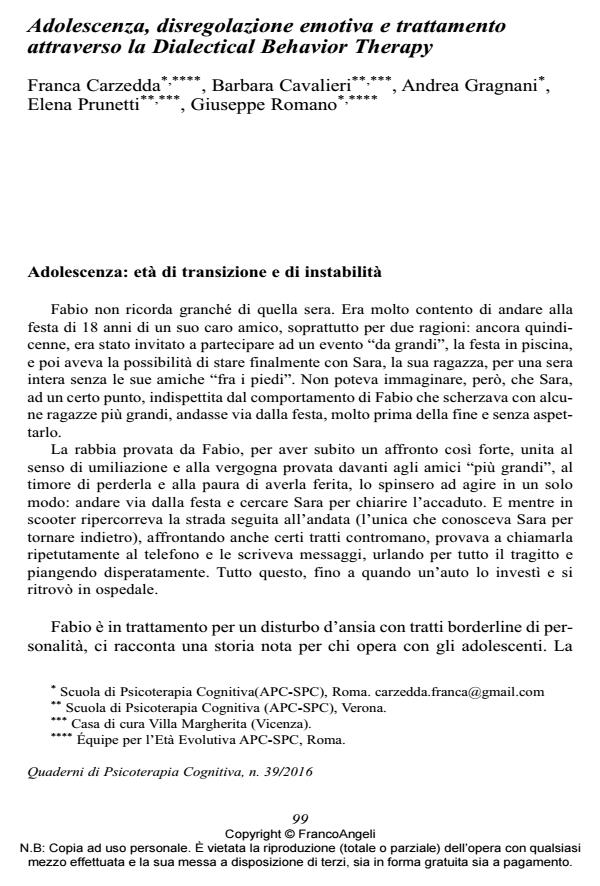Adolescenza, disregolazione emotiva e trattamento attraverso la Dialectical Behavior Therapy
Titolo Rivista QUADERNI DI PSICOTERAPIA COGNITIVA
Autori/Curatori Franca Carzedda, Barbara Cavalieri, Andrea Gragnani, Elena Prunetti, Giuseppe Romano
Anno di pubblicazione 2016 Fascicolo 2016/39
Lingua Italiano Numero pagine 22 P. 99-120 Dimensione file 157 KB
DOI 10.3280/QPC2016-039007
Il DOI è il codice a barre della proprietà intellettuale: per saperne di più
clicca qui
Qui sotto puoi vedere in anteprima la prima pagina di questo articolo.
Se questo articolo ti interessa, lo puoi acquistare (e scaricare in formato pdf) seguendo le facili indicazioni per acquistare il download credit. Acquista Download Credits per scaricare questo Articolo in formato PDF

FrancoAngeli è membro della Publishers International Linking Association, Inc (PILA)associazione indipendente e non profit per facilitare (attraverso i servizi tecnologici implementati da CrossRef.org) l’accesso degli studiosi ai contenuti digitali nelle pubblicazioni professionali e scientifiche
I numerosi cambiamenti che l’individuo attraversa in adolescenza, unitamente ad alcune caratteristiche come, ad esempio, la tendenza alla sperimentazione, la ricerca di sensazioni forti e il bisogno di autonomia rendono complesso e difficile l’intervento psicoterapeutico. Lo specialista che si occupa di adolescenti sa che queste peculiarita mettono alla prova le capacita di autoregolazione dei soggetti rispetto a una varieta di rischi connessi alla salute e all’adattamento. Indipendentemente dalle problematiche per cui e richiesto l’aiuto, in questa fascia di eta, pertanto, sara importante intervenire sulla gestione delle emozioni e sul controllo del comportamento. In questo articolo ci occuperemo di definire la regolazione e la disregolazione emotiva e comportamentale e presenteremo un intervento di Dialectical Behavior Therapy che da pochi anni e stato adattato anche all’adolescenza.
Parole chiave:Adolescenza, disregolazione emotiva, Dialectical Behavior Therapy
Franca Carzedda, Barbara Cavalieri, Andrea Gragnani, Elena Prunetti, Giuseppe Romano, Adolescenza, disregolazione emotiva e trattamento attraverso la Dialectical Behavior Therapy in "QUADERNI DI PSICOTERAPIA COGNITIVA" 39/2016, pp 99-120, DOI: 10.3280/QPC2016-039007